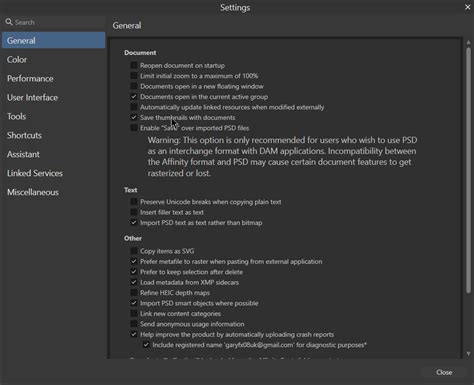Boost Your Affinity Photo: End the Lag

Are you an avid user of Affinity Photo, seeking to enhance its performance and bid farewell to frustrating lags? This comprehensive guide is designed to empower you with practical strategies and expert insights, ensuring your photo editing experience is smooth and efficient. Discover a range of techniques, from optimizing system resources to harnessing the full potential of Affinity Photo's features, to unlock a seamless and productive workflow.
Maximizing Performance: A Comprehensive Guide

In the realm of photo editing, performance is paramount. Affinity Photo, with its powerful capabilities, demands an optimized setup to deliver its best. This section will delve into the essential aspects of boosting your Affinity Photo performance, covering system requirements, hardware optimization, and efficient software settings.
System Requirements: A Foundation for Smooth Performance
Affinity Photo, developed by Serif, is renowned for its high-performance editing capabilities. However, to ensure a lag-free experience, meeting the minimum system requirements is crucial. Here’s a breakdown of the recommended specifications:
- Operating System: Windows 7 or later, macOS 10.12 or later.
- Processor: Intel Core i3 or higher, with 4 cores and 64-bit support.
- Memory: At least 4 GB RAM, but 8 GB or more is recommended for optimal performance.
- Graphics: Intel HD Graphics 4000 or higher, with 256 MB VRAM.
- Storage: 1 GB free space for installation, with SSD preferred for faster loading.
While these are the minimum requirements, aiming for higher-end specifications can significantly enhance performance, especially when working with large, high-resolution images.
Hardware Optimization: Unleashing Your System’s Potential
Maximizing your hardware’s capabilities is a key strategy to boost Affinity Photo’s performance. Here are some hardware-related tips:
- CPU: Affinity Photo is a CPU-intensive application. Upgrading to a faster processor, especially one with more cores, can provide a noticeable performance boost.
- RAM: Increasing your system’s RAM is a simple yet effective way to improve performance. With more RAM, Affinity Photo can handle larger projects and complex editing tasks more efficiently.
- Graphics Card: While Affinity Photo relies more on CPU than GPU, a dedicated graphics card with higher VRAM can improve performance, especially when working with 3D or panoramic images.
- Storage: Using an SSD for your operating system and Affinity Photo installation can significantly reduce loading times. Additionally, storing your image files on a separate, fast storage device can improve overall performance.
Software Settings: Fine-Tuning for Maximum Efficiency
Beyond hardware, optimizing Affinity Photo’s software settings is essential. Here are some key adjustments to consider:
- Preferences: Access the Preferences menu and customize settings like the number of Undo levels, cache size, and memory allocation. Adjusting these can fine-tune Affinity Photo’s performance to your specific needs.
- Preview Quality: Reducing the preview quality can speed up editing, especially when working with complex images. This setting can be found in the View menu.
- Plugin Management: Disable or remove unnecessary plugins to reduce Affinity Photo’s startup time and improve overall performance. Only keep the plugins you regularly use.
- Clear Cache: Regularly clearing the cache can free up system resources and improve performance. This can be done via the Preferences menu or by manually deleting the cache files.
Efficient Workflow Strategies

Optimizing your workflow is another crucial aspect of boosting Affinity Photo’s performance. This section will explore practical strategies to streamline your editing process, from organizing your workspace to utilizing efficient file management techniques.
Workspace Organization: A Tidy Workspace, a Clear Mind
A well-organized workspace can significantly improve your productivity and reduce lag. Here’s how to achieve an efficient workspace in Affinity Photo:
- Customizing the Interface: Adjust the interface layout to suit your preferences and workflow. Arrange panels and tools in a way that minimizes the need for excessive clicking or scrolling.
- Using Presets: Affinity Photo offers a range of presets for various tasks, from color grading to retouching. Using presets can save time and reduce the need for complex adjustments.
- Keyboard Shortcuts: Master the use of keyboard shortcuts. This not only speeds up your workflow but also reduces the strain on your system by minimizing mouse movements and clicks.
File Management: The Key to a Smooth Workflow
Efficient file management is essential for a lag-free editing experience. Here are some best practices:
- Organize Your Files: Create a consistent naming and filing system for your images. This makes it easier to locate specific files and reduces the time spent searching for assets.
- Use Smart Objects: Affinity Photo’s Smart Objects feature allows you to work with layered Photoshop files without expanding them. This can significantly reduce file size and improve performance when working with complex PSD files.
- Batch Processing: Utilize Affinity Photo’s batch processing feature to automate repetitive tasks. This not only saves time but also reduces the load on your system by performing multiple edits in a single pass.
Advanced Techniques: Mastering the Software’s Full Potential
To truly boost your Affinity Photo experience, it’s essential to master some of the software’s more advanced features. Here’s a glimpse into what you can explore:
- Non-Destructive Editing: Affinity Photo’s history panel allows you to work non-destructively, ensuring you can always revert changes. This not only protects your original image but also improves performance by reducing the need for frequent saving.
- High-Performance Features: Affinity Photo offers a range of high-performance features like Content-Aware Fill, which can quickly remove unwanted objects from images. Understanding and utilizing these features can significantly speed up your editing process.
- Performance Monitoring: Affinity Photo provides tools to monitor its performance, such as the Performance Monitor panel. This panel gives insights into memory usage, CPU load, and other metrics, helping you identify and address performance bottlenecks.
Future-Proofing Your Setup: Staying Ahead of the Curve
In the fast-paced world of photo editing, staying ahead of the curve is essential. This section will discuss strategies to future-proof your Affinity Photo setup, ensuring it remains performant and relevant in the long term.
Regular Updates: Staying Current with the Latest Advances
Keeping your Affinity Photo software up-to-date is crucial. Updates often bring performance improvements, bug fixes, and new features that can enhance your editing experience. Here’s how to stay current:
- Automatic Updates: Enable automatic updates in the software’s preferences. This ensures you always have the latest version without manual intervention.
- Update Frequency: Affinity Photo releases updates regularly, often incorporating user feedback and addressing performance issues. Keeping a close eye on release notes can help you understand the impact of each update on your workflow.
- Beta Testing: For those comfortable with potential risks, participating in beta testing programs can provide early access to new features and performance improvements. However, it’s important to use this version only on non-critical projects.
Long-Term Hardware Planning: Ensuring Sustainability
While hardware upgrades can provide an immediate performance boost, planning for the long term is crucial. Here are some strategies for future-proofing your hardware:
- Upgradable Hardware: When purchasing new hardware, opt for components that allow for future upgrades. For instance, choose a motherboard that supports the latest CPU generations or a graphics card with a higher VRAM capacity.
- Storage Scalability: Consider using RAID (Redundant Array of Independent Disks) configurations to increase storage capacity and improve performance. This can be especially beneficial when working with large image libraries.
- Future-Proof Processors: Research and invest in processors that are likely to remain relevant for the long term. This often involves opting for processors with higher core counts and advanced technologies like hyper-threading.
Adapting to New Technologies: Embracing the Future
The world of photo editing is rapidly evolving, with new technologies like machine learning and cloud computing gaining traction. Here’s how to stay ahead:
- Machine Learning: Affinity Photo already incorporates some machine learning features, like the intelligent selection tool. Stay updated on developments in this field, as future updates may bring more powerful AI-assisted tools.
- Cloud Computing: While cloud-based photo editing is still in its infancy, it has the potential to revolutionize the industry. Consider experimenting with cloud-based photo editing tools to stay ahead of the curve.
- VR and AR: Virtual and augmented reality technologies are gaining momentum in photo editing. While still in their early stages, exploring these technologies can provide a competitive edge and enhance your creative capabilities.
Conclusion: A Seamless, High-Performance Experience
By implementing the strategies outlined in this guide, you can transform your Affinity Photo experience, ensuring a seamless, high-performance workflow. From optimizing system resources to embracing future technologies, each step brings you closer to a lag-free, efficient photo editing environment.
How often should I update my Affinity Photo software?
+It’s recommended to keep your Affinity Photo software up-to-date with the latest version. Major updates often bring performance improvements and new features, while minor updates focus on bug fixes and stability enhancements. Consider enabling automatic updates to ensure you always have the latest version.
Can I use Affinity Photo on older hardware?
+While Affinity Photo is designed to run on a wide range of hardware, older systems may struggle to keep up with its demands. To ensure a smooth experience, it’s recommended to meet or exceed the minimum system requirements. Upgrading key components like the CPU, RAM, and storage can significantly improve performance on older hardware.
How can I improve Affinity Photo’s performance on my laptop?
+To boost Affinity Photo’s performance on a laptop, consider the following: Ensure your laptop meets the minimum system requirements, especially for RAM and storage. Disable unnecessary background apps to free up resources. Use an external monitor to reduce the load on your laptop’s integrated graphics. And finally, consider upgrading your laptop’s RAM or storage if possible.



